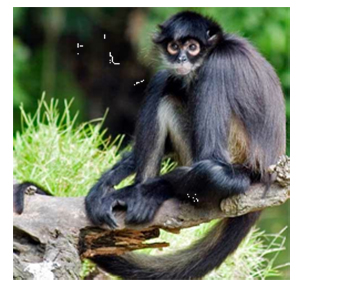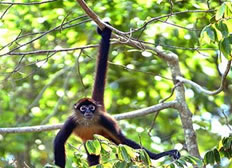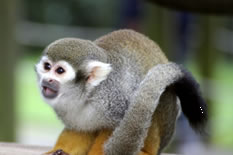Spider Monkey
Atelidae ateles

Taxonomy
Kingdom: Animalia
Phylum: Chordata
Class: Mammalia
Order: Eutheria
Family: Primates
Genus: Atelidae
Species: Ateles
Facts
Common name: Spider Monkey
Scientific name: Atelidae ateles
Average size: 6 feet tall
Longevity: At least 27 years
Distribution: Southern Mexico and most tropical regions of Central and South America
Life history/ecology:
Habitat and morphology: Spider monkeys grow up to be about 2 feet tall not including their tail. The color of their fur is usually black, brown, golden, red, or tan. Their tail is extremely powerful and is most of the time used as an extra limb. They use their tail to hang upside down from branches making them look like spiders, hence why the name. They also use their tail and four limbs to swing from branch to brand, tree to tree, at a very high speed. They don’t have thumbs but even without them they manage to be some of the best climbers/swinging monkeys out there thanks to their tail. Due to their lack of thumbs, grooming is a harder for them so they resort to scratching with their hands and feet. Most of their grooming was done when they were still under their mothers care. They usually live high up in the evergreen rainforest, semi deciduous, and mangrove forest, and rarely ever come down to the ground. They like to live in the upper canopy of the rainforest where they are least disturbed.
 Behavior: Spider monkeys don’t like to live alone; they usually live in a group of about 30 individuals, which fragment into smaller groups of 3 individuals when food is scarce. Those smaller groups will venture out to a specific area for food. Contrary to normal, the female has a more active leading role than the male species. It seems as if the routes taken by the female spider monkey are planned, far more advanced, and are different from day to day. This planned type behavior of females causes them to have a greater variety of diet compared to the males. Spider monkeys are active during the day and sleep in the canopy at night where they are protected from predators. Spider monkeys tend to sleep nearby their food source so that it is readily available when they need it. They don’t carry food around to another location; they tend to eat their food at the location that they found it. When threatened, spider monkeys (both male and female) scare off the intruder by barking and displaying wild behavior. If that doesn’t work out, they chose to run away instead of dealing with a confrontation. In general, they’re fairly loud animals and like making barking and screeching noises.
Behavior: Spider monkeys don’t like to live alone; they usually live in a group of about 30 individuals, which fragment into smaller groups of 3 individuals when food is scarce. Those smaller groups will venture out to a specific area for food. Contrary to normal, the female has a more active leading role than the male species. It seems as if the routes taken by the female spider monkey are planned, far more advanced, and are different from day to day. This planned type behavior of females causes them to have a greater variety of diet compared to the males. Spider monkeys are active during the day and sleep in the canopy at night where they are protected from predators. Spider monkeys tend to sleep nearby their food source so that it is readily available when they need it. They don’t carry food around to another location; they tend to eat their food at the location that they found it. When threatened, spider monkeys (both male and female) scare off the intruder by barking and displaying wild behavior. If that doesn’t work out, they chose to run away instead of dealing with a confrontation. In general, they’re fairly loud animals and like making barking and screeching noises.
 Nutrition and symbiosis: Spider money’s don’t prey on other mammals; they’re considered to be frugivorous species indicating that they prefer a diet of fruits and seeds. Most monkeys only eat bananas, as we are taught since we are little but spider monkeys are different because they also eat young leaves, eggs, nuts, flowers, aerial roots, bark, decaying wood, and honey. Although they like to eat the most nutritious, large, fleshy seeded fruits they also eat insects. When they go out to find food, it is the female that leads the food picking ventures.
Nutrition and symbiosis: Spider money’s don’t prey on other mammals; they’re considered to be frugivorous species indicating that they prefer a diet of fruits and seeds. Most monkeys only eat bananas, as we are taught since we are little but spider monkeys are different because they also eat young leaves, eggs, nuts, flowers, aerial roots, bark, decaying wood, and honey. Although they like to eat the most nutritious, large, fleshy seeded fruits they also eat insects. When they go out to find food, it is the female that leads the food picking ventures.
Recent research: The only research out there on spider monkeys is still educational, they’re trying to learn more about the species. They do research out there on the type of sound spider monkey’s make, how they behave amongst one another and their environment, what they feed on, how they take care of their offspring, etc.
 Reproduction: A female is sexually mature between the ages of 4 and 5. The female has an estrus cycle of 26 days, compared to the human female that has a 28-day cycle. The gestation period is about 226-232 days. Males are sexually mature at the age of 5. The strange behavior that spider monkeys exhibit while copulating is that they are very secretive; they don’t like having a crowd watching. After the baby is born, the baby spider monkey is continuously carried by the mother and once it reaches 5 months of age, the baby will start riding on her back. The baby will drink milk from the mom until he/she turns 2 years old. They generally stick with the mother until they are 3.5 years old. Spider monkeys have a relatively large brain for their body size and therefore they try to learn as much information from their mother before they go their separate ways.
Reproduction: A female is sexually mature between the ages of 4 and 5. The female has an estrus cycle of 26 days, compared to the human female that has a 28-day cycle. The gestation period is about 226-232 days. Males are sexually mature at the age of 5. The strange behavior that spider monkeys exhibit while copulating is that they are very secretive; they don’t like having a crowd watching. After the baby is born, the baby spider monkey is continuously carried by the mother and once it reaches 5 months of age, the baby will start riding on her back. The baby will drink milk from the mom until he/she turns 2 years old. They generally stick with the mother until they are 3.5 years old. Spider monkeys have a relatively large brain for their body size and therefore they try to learn as much information from their mother before they go their separate ways.
Economical services: People in today’s world like to use animal fur, as is the case with spider monkeys. They are considered endangered species because of their skin and appearance. Spider monkeys actually do serve a very important ecological role throughout the tropical rainforests. As they eat the fruit, they also ingest the seed inside of it. As the fruit travels through their digestive system and is excreted, that seed is most likely to be placed at a new location where, in favorable conditions, will germinate into another plant of that species. This is called animal pollination.
Personal interest: I’ve always had a fascination with monkeys, any type of monkey actually. However, I’ve never liked spiders, so putting the name “spider” and “monkey” together is definitely naturally appealing. As a little girl, I used to climb mangroves in Aruba all the time. That’s what my sister and I would do on a weekly basis down at the beach. We loved swinging from one branch to the next from one end of the mangroves to the other. One could say that I’ve considered myself a “monkey” once upon a time in my childhood. It fascinated me how monkeys can swing from one tree to the next at such a high speed without falling, because I guarantee that I’ve falling a time or two. I’m very glad that I picked the spider monkey and I hope I’ll be able to see one in Belize.
Work Cited
Please note that the following references may have either been removed or relocated by the webpage owners since the time this student report was created.
“Spider Monkey.” Honolulu Zoo, n.d. Web. 29 May 2012. <http://www.honoluluzoo.org/spider_monkey.htm>.
“Spider Monkey- Mammal.” Spider Monkey, n.d. Web. 29 May 2012. <http://rainforest.montclair.edu/pwebrf/rainforest/Animals/mammals/spidermonkey.html>
“Spider Monkey.” Spider Monkey, n.d. Web. 29 May 2012. <http://www.amersol.edu.pe/ms/7th/7block/jungle_research/new_cards/20/report_20.html>.
“Primate Research.” Primate Research, n.d. Wed. 29 May 2012. <https://webspace.utexas.edu/ad26693/www/yasuni/research.html>.
External Links
http://www.youtube.c http://www.youtube.com/watch?v=1-8mmtjcXXwom/watch?v=1-8mmtjcXXw